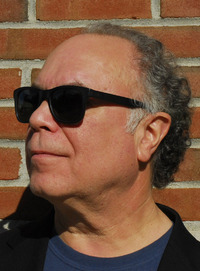THE GLORY DAYS, PART III.
 Monday, July 31, 2017 at 08:31AM
Monday, July 31, 2017 at 08:31AM Editor's Note: Peter is taking a much-needed summer break from writing "Fumes," although he will write a new column if news from the sport dictates as such, and we will continue our weekly racing updates in "The Line." But as a bonus, we're going to be re-running Peter's riveting series, "The Glory Days," in its entirety over the next several weeks. The inside story of Tony DeLorenzo's racing career (Peter's brother), one of the most successful Corvette racers of all time - including the fantastic exploits of the famous Owens/Corning Fiberglas Racing Team - was one of the most widely read and popular pieces ever to appear in Autoextremist.com. So enjoy, because it was a different time and a different era, one never to be repeated. -WG
By Peter M. DeLorenzo
© 2017 Autoextremist.com
Detroit. In my two previous columns ("The Glory Days, Part I" and "The Glory Days, Part II"), I recalled for our Autoextremist readers the early days of my brother Tony's racing career, which saw us go from our adventure at an SCCA driver's school at Watkins Glen, New York, in 1964, to a growing posse of friends and volunteers getting together to help Tony field a car as he climbed the racing ladder. The story progressed through a couple of years of racing a Corvair in SCCA "A Sedan," to racing a Corvette in major SCCA National races in the Midwest, through a gradual transition to a full-fledged, fully-sponsored effort that not only brought sponsor Owens/Corning Fiberglas to the sport, but ushered in a whole new style of sponsor activation at racing events.
As I discussed last week, the burgeoning OCF Corvette Racing Team survived the debacle at the Daytona 24 Hour race and found a measure of redemption at the 12 Hours of Sebring - this country's most prestigious and toughest endurance road race - when Jerry Thompson and Gib Hufstaeder (another Chevrolet engineer) finished the race. But the bad luck continued for the other OCF team car wheeled by Tony and Dick Lang, as the machine was plagued with problems, among them an axle failure and finally, a broken half shaft, which ended the effort. There's a video out there on the Internet about that year's race at Sebring that gives a brief glimpse of Tony dragging a floor jack with the 90lb. rear axle and a bag of tools perched on it across the sandy ground. Brutal. (Back then drivers had to do the on-track repairs of their cars, or they would be disqualified from the event.)
As things progressed on the track, the Owens/Corning Fiberglas Corvette Racing Team began the transformation into a well-oiled machine. Seasoned by battles at America's two most famous endurance races at Sebring and Daytona, the OCF team became a force to be reckoned with everywhere they raced. The famous volunteer posse made up of some of the "best and brightest" from Chevrolet Engineering, GM Design and others (Chief Mechanic Art Jerome was a packaging engineer at Ford) began to really gel, which helped keep the team running at an exceedingly high level. But as success on the track grew, the notoriety - and the expectations - for the team grew with it.
After the battles at Daytona and Sebring, the OCF team turned its sights back to racing in SCCA Nationals, while keeping their eye on the 6-Hour FIA race at Watkins Glen, which was looming for mid-summer. If you perused the photos from last week, you could see Tony leading Jerry in a torrential downpour to a 1-2 finish in an SCCA National at the famed Meadowdale Raceway on the outskirts of Chicago. This race marked the return of the team to SCCA "A Production" racing in the Central Division and it also marked the start of "The Streak" - an incredible run of 22 straight race wins - in which the team finished 1-2 in fourteen of them (it also marked the last race ever run at Meadowdale). "The Streak" ran from March of 1969 to November 1970. It included races in "A Production" (and Jerry's SCCA National Championship at Daytona International Raceway in 1969) and triumphs in FIA GT. You can actually get a (very) brief look at Jerry (No. 7) and Tony (No. 1) leading the pack (in black & white) at the SCCA Runoffs in 1969 in the opening of their Corvette Hall of Fame induction video here. Tony and Jerry qualified 1-2 at the '69 Runoffs, with Jerry going on to the win as Tony's race was ruined by two flat tires, dropping him way down the field at the finish.
I closed last week's column with a photo of the No. 14 Owens/Corning Fiberglas Corvette at the Watkins Glen 6-Hour FIA race, the team's first win in major league international competition. The OCF team approached the FIA race at The Glen with a measure of optimism, and for good reason. Tony and Jerry not only were intimately familiar with the track; the team was really firing on all cylinders, having decimated SCCA competition all over the Midwest. Tony and Dick Lang would be driving the No. 14 OCF Corvette 427 L88, while Jerry would be sharing the No. 15 team car with Bill Morrison. Bill was a good friend of Tony's and a veteran competitor in SCCA "A Production" competition in the Midwest as well. (Tony would go on to drive with Bill at several races including an IMSA race on the road course at Talledega in 1972.)
An interesting dimension to the story that weekend at The Glen? The 6-Hour FIA race shared the weekend with the legendary Can-Am series. Just being at The Glen and seeing the factory McLarens driven by Bruce McLaren and Denny Hulme was a life-altering experience. To this day there is nothing, and I mean nothing like a well-prepared Can-Am car at full chat. I will return to The Glen weekend in a moment, but I'm going to interrupt this story to give you a little perspective for the next scene.
Tony and I and some friends had traveled to Meadowdale Raceway back in August of 1964 to see the USRRC series (United States Road Racing Championship) race weekend, which was the pinnacle of American road racing at the time. This was the first professional road racing I had ever seen in person, and it was Tony's second (he had been to Meadowdale the year before). The USRRC race weekends consisted of a GT race (Corvettes, Cobras, Jaguars, etc.) as the opener, followed by the big sports cars (Chaparral, etc.) as the feature. We watched as the factory Shelby American Cobra team led by Ken Miles (No. 98) and Bob Johnson (No. 99) dominated the field, finishing 1-2, followed by three independently-entered Cobras. The best Corvettes in the country were there and they were utterly humiliated, not only racing seconds a lap off of the pace, but none of them finished.
Then something fascinating happened. We watched as the crack Shelby American crew swarmed over Miles' Cobra immediately following the GT race. They took the full windshield off, replacing it with a tiny plexiglass bubble windscreen, filled it up with racing gas, and rolled it to the very back of the USRRC sports car race grid in 27th position. Dead last. It seems that the officials had allowed the team to enter Miles in the race with no qualifying time.
We were then treated to one of the most dazzling displays of race driving we had ever seen, and it still resonates to this day. Jim Hall (No. 66 Chaparral 2A) dominated the race, followed by his now-legendary teammate, Roger Penske (No. 67 Chaparral 2A) for a memorable 1-2 for the Texas Road Runners. Dick Doane (No. 29 McKee Chevette Mk 1) finished third (sound familiar? Chevrolet would buy the rights to the Chevette name from McKee for the production car of the same name), and George Wintersteen (No. 12 Cooper Monaco T61M Chevrolet) finished fourth. And Mr. Miles? He would charge from the back of the field in a jaw-dropping run that would see him finish fifth - in his 289 Cobra - just one lap behind the winners. Believe me, this isn't a case of appreciating something from the past more now; no, we appreciated what we were seeing, in real time. It was simply fantastic and amazing, in the true sense of that overused word.
Back to The Glen. Tony recalled Miles' incredible feat from that Meadowdale weekend and thought, hmm, what if? As the team set up for the Glen 6-Hour FIA race on Saturday, Tony informed the stewards he wanted to run the OCF Corvettes in the Can-Am race on Sunday. Tony and Jerry went out during a Can-Am practice session with the hardtops removed to save weight. They posted times, remarkably enough, that would have put them in the top fifteen for the Can-Am race. As the team continued preparations for the 6-Hour, the stewards met with Tony and said that the OCF Corvettes somehow, "didn't match the spirit of the event" (!) and that the team wouldn't be allowed to run in the Can-Am race. As I've said countless times in this column, politics suck. And politics in racing really suck. Ah well.
The important thing was that Tony and Dick Lang won the GT+2.5L class and finished 7th overall in the No. 14 OCF Corvette, even making the New York Times sports section with a picture on Sunday morning. Jerry and Bill didn't fare so well as Jerry got off track at the top of the hill in Turn 3, which resulted in a big crash, severely damaging the car. As Tony recalls, "Jerry was okay, but the car? Not so much. To add insult to no injury, the storied 'Bog People' at The Glen stole much of the bodywork from the race car. Less for us to carry home, but that sucked too."
1969 was a fantastic year. The Owens/Corning Corvette Racing Team hadn't lost a race after Sebring in March, and the boys closed out the season with a SCCA National Championship for Jerry Thompson. But the stakes - as well as the expectations - grew higher for 1970, and the team spent the Michigan winter hard at work on nights and weekends, preparing for the 1970 Daytona 24 Hour race, which would be quickly followed by the 12 Hours of Sebring.
Daytona, which always seemed to be a long way off after the Runoffs in November, came up soon, and the nights and weekends transitioned to a non-stop ten-day frenzy in order to get everything ready for the transporter leave date. The cars would debut special paint jobs - again designed by famed GM designer Randy Wittine - that would feature black (the preferred DeLorenzo brothers color) on the tops of the cars. Tony had convinced OCF's ace PR man, Roger Holliday, and others in Toledo (where OCF's headquarters were) that it would be "fine."
When the OCF entourage arrived at Daytona, nobody said a word about it. But it wasn't just the addition of black paint that was a little disconcerting. Each car had a personalized touch, courtesy of Randy, that was supposed to symbolize Tony and Jerry, respectively. Jerry's car had an ear of corn hand painted on the beak of the nose, which was a tribute to his Iowa roots. While Tony's car had an intricate spider - with Italian overtones - hand painted on the nose of his car. Everyone on the crew loved it, and everyone who saw the cars loved the overall look. And even better, the race itself was another triumph for the team, as Jerry and co-driver John Mahler won the GT+2.5L class, finishing an impressive 6th overall. We had started to get our long-distance act together, and the OCF Corvette Racing Team was becoming well known in the racing world.
But that wasn't the end of the "black paint" story, oh no. It seems that certain Owens/Corning Fiberglas executives were none too amused by the introduction of black to the paint schemes. So when the team got back from Daytona, Tony and Jerry were summoned to Toledo for a meeting, whereupon they were publicly castigated and flogged for the sin of violating corporate color codes. Then, as Tony remembers, "They took us out and fed us, got us drunk and sent us home." The cars never appeared in that livery again.
And the 12 Hours of Sebring in that 1970 season would be another interesting chapter in the story.
Flush with success and brimming with confidence after the stellar run at Daytona, the OCF team would arrive at Sebring a week early to take part in a test session. We rented aircraft hangers to house the cars and equipment while we worked through the schedule. The big factory teams that year were led by the 5-liter Porsche 917K and the Ferrari 512M prototypes. Mario Andretti led the Ferrari team, while Pedro Rodriquez, Leo Kinnunen and Jo Siffert led the John Wyer Porsches. The Alfa Romeo T33/3 team also raced with Toine Hezemans and Masten Gregory together. The 5-liter prototypes were blindingly fast with around 600HP. The 3-liter Alfas and Porsches were also agile, light and fast. And Steve McQueen and Peter Revson shared a 908/02 Porsche powered by a 3.0-liter flat 8-cylinder engine.
During the week of the race, Tony was dispatched from the hanger to warm up one of the Corvettes so the crew could make some engine checks. Tony recalls: “I had shut the engine off and was waiting for the guys to push the car back to the hanger and a mini bike came putting up. Riding it was none other than Steve McQueen. Steve introduced himself and we talked for about ten minutes about racing, his broken ankle (dirt bike accident), and other stuff. He was just a regular, nice guy and was looking forward to the race. I never forgot that brief meeting."
The 1970 12 Hours of Sebring was the first to use a rolling start and the OCF team had qualified 1-2 in the GT +5.0 class. Previously, race organizers had used the famous “Le Mans” start where you run across the track and chaos ensues. The start went without drama and the OCF drivers settled into their rhythm. Dick Lang and Tony reported no issues. Sebring ’70 has been described by some as the greatest Sebring ever (watch a video here). Mario and the Porsches were fighting it out for the lead all day but Mario’s 512M broke. The Porsches had issues too, so, later in the afternoon the lead car was the 908 Porsche of Revson and McQueen, with Revson doing most of the driving. The Ferrari team manager asked Mario if he would consider getting into the 512 of Ignacio Giunti/Nino Vacarella. Mario accepted. Later, Mario told Tony that the seat fit wasn’t too bad and he "could push the car pretty hard."
Tony had this to say: "Dick and I tried to mind our own business but a GT car is 'stuck in the middle' – faster than all but the big prototypes. So you constantly had to watch your mirrors as they approached. About an hour from the end I got back in the car with a five-lap lead over the Doug Bergen Corvette driven by 'Marietta' Bob Johnson, 'Columbus' Bob Johnson and Jim Greendyke. They were fellow SCCA Central Division 'A Production' competitors. I was aware that there was drama unfolding before I got back in the car to finish the race, as Mario was catching Peter Revson at a furious pace. With less than a half-hour to go I was passing the pits and into the flat out left-hander, which was followed by a short straight, then a 90 degree left into the infield. As I entered the left I saw three slower cars in front of me. At the same time I saw the telltale headlights of Mario’s 512 coming up behind me. The next set of turns were the esses, a fast left/right combination leading down to the famous hairpin that had a large sandbank waiting to catch you if you made any errors."
"The next couple of seconds was a late race demo of why Mario is Mario. I stayed behind the slower cars as Mario inhaled us. The fast left hand sweeper at the start of the esses would normally be apex left. Not Mario. He drove the 512 like he was on the dirt at Langhorne. He flicked the 512 right and slid across the apex in a right hand drift. That set him up perfectly to stand on the gas way early for the right hand ess leading down to the hairpin. He was gone in an instant. I remember it like it was yesterday!"
Mario caught Peter but had to come in for a splash of fuel and had to re-catch him. So the race ended with Mario leading by 22 seconds. Peter and Steve were second and won the 3-liter prototype class. The Hezemans/Gregory Alfa T33/3 finished 3rd. Tony and Dick Lang finished 10th overall and 1st in GT +5.0. Jerry and John Mahler finished 4th in GT and 20th overall. At Sebring they close off a portion of the pit straight for the winners enclosure. The Ferrari team, Steve and Peter, the OCF team and the Touring class winners were all there; it was happy bedlam.
1970 had started with a bang, with the Owens/Corning Fiberglas Corvette Racing team delivering major GT victories in America's premier endurance races at Daytona and Sebring. And that made it three straight major GT wins counting back to The Glen in the summer of '69.
But the team was just hitting its stride, and the biggest win was yet to come.
Stay tuned for Part IV.
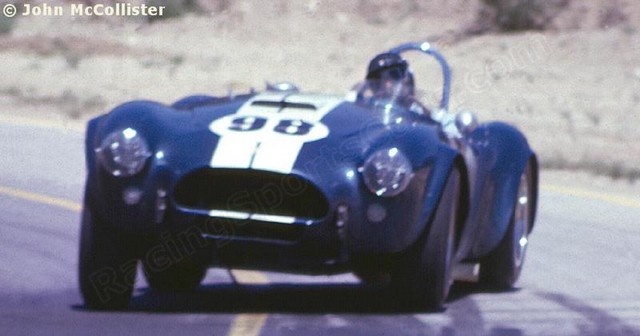
(Photo by John McCollister/Courtesy of RacingSportsCars.com)
After dominating the GT race during the USRRC race weekend at Meadowdale Raceway in August of 1964, the crack Shelby American crew swarmed over Ken Miles' Cobra immediately following the race taking the full windshield off, replacing it with a tiny plexiglass bubble windscreen, and filling it up with racing gas. They then rolled it to the very back of the USRRC sports car feature race grid in 27th position. Dead last. The officials had allowed the team to enter Miles in the race with no qualifying time. Miles (above) then put on one of the most dazzling displays of race driving we had ever seen, and it still resonates to this day. Miles would charge from the back of the field in a jaw-dropping run that would see him finish fifth overall - in his 289 Cobra - just one lap behind the winners. It was simply fantastic and amazing, in the true sense of that overused word.
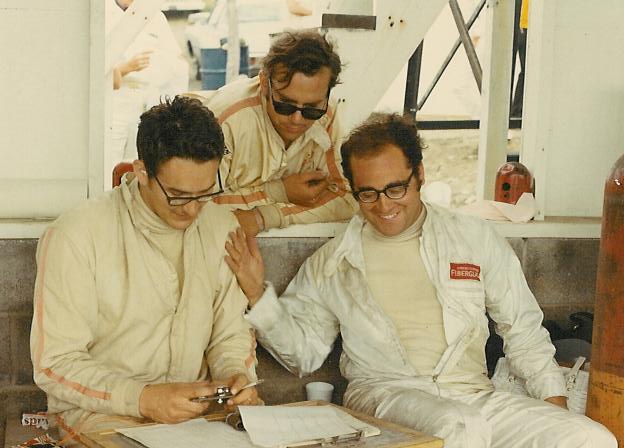
(Photo by Roger Holliday/The DeLorenzo Collection)
Jerry, Bill Morrison, and Tony share a laugh prior to the start of The Glen 6-Hour race. Tony and Dick Lang won the GT +2.5L class finishing 7th overall, as Jerry and Bill DNF due to Jerry's big crash in Turn 3. The low light? The storied "Bog People" stripped much of the bodywork from the race car. It was the beginning of a string of successes for the Owens/Corning Fiberglas Corvette Racing Team in FIA long distance races.
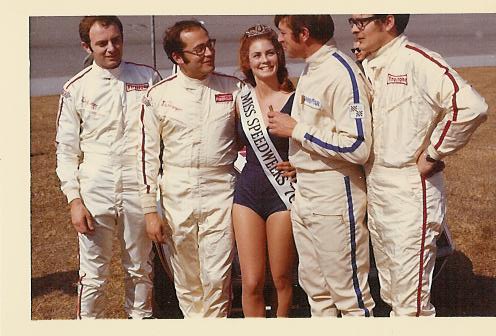
(Photo by Roger Holliday/The DeLorenzo Collection)
The Owens/Corning Fiberglas Corvette Racing Team drivers (L-R) Dick Lang, Tony DeLorenzo, John Mahler and Jerry Thompson pose with Miss Speedweeks before the start of the 1970 Daytona 24 Hour race.
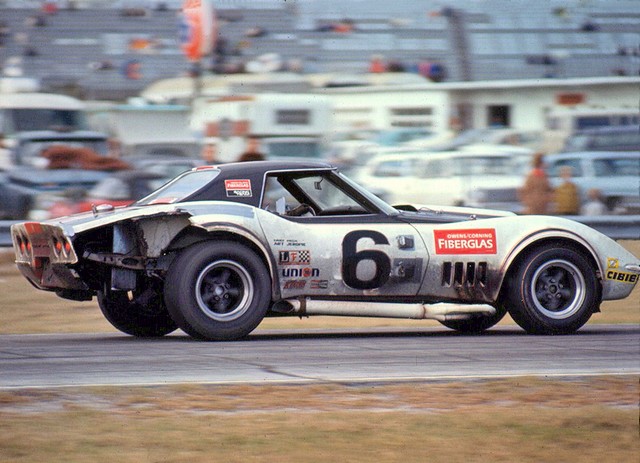 (Photo by Hal Crocker/The DeLorenzo Collection)
(Photo by Hal Crocker/The DeLorenzo Collection)
The battered No. 6 Owens/Corning Fiberglas Corvette 427 L88 driven by Tony and Dick Lang heads for the finish at Daytona in 1970. With Dick driving, the driveshaft failed around 1:00 a.m. and Tony dragged the jack and tools out to the inside of the infield “Horseshoe” (Turn 2) to fix it. Tony recalls: "It was dark and scary! I don’t remember which crewman supervised the operation. When I got back to the pits the crew put another driveshaft in 'just in case!' Wait… what? " But that wasn't all. Around 10:00 a.m. the next morning, again with Dick at the wheel, the studs on the RR wheel sheared in Turn 1 and away went the wheel, taking the fender with it. Once again Tony dragged the jack and tools out to the car for the repair (he was getting good at this by now). This time the OCF team axle expert, “Spike” Ollilla, accompanied Tony to supervise. The repair required that the wheel studs, what was left of them, be removed using a punch and hammer. Here's Tony again: "I was not good at this as it required brute force, but Spike was very patient. When I managed to get two of them out, Spike said: 'Two lug nuts is enough, don’t go real fast on the way back to the pits!' I watched Spike remove the other three with one hammer blow each!" After those multiple thrashes it still turned out to be a Good Day for the team as Jerry and John Mahler (No. 7 OCF Corvette 427 L88) won the GT +2.5L class, finishing 6th overall. The Owens/Corning Fiberglas Corvette Racing Team was getting its long-distance racing act together.
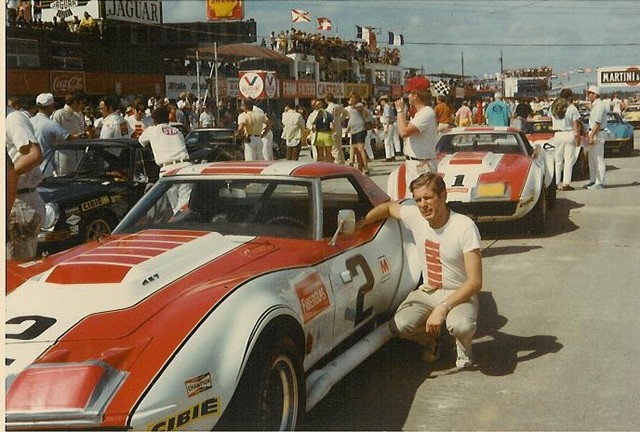
(Photo by Roger Holliday/The DeLorenzo Collection)
Crewman Ken Weidbusch (Electrical) with Fred McKenna (tires) at rear of the No. 2 OCF team car on the grid, pre-race, 1970 12 Hours of Sebring.
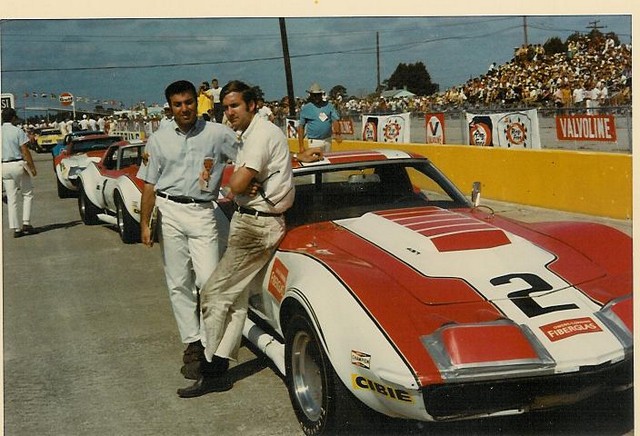 (Photo by Roger Holliday/The DeLorenzo Collection)
(Photo by Roger Holliday/The DeLorenzo Collection)
Pre-race, 12 Hours of Sebring, 1970. Crew chief for the No. 2 OCF Corvette Racing Team car, Greg Syfert, relaxes before the race. A pit steward is on the left. A true talent, Greg would go on to become one of the key crew members for Roger Penske and Mark Donohue at Penske Racing during the Porsche Can-Am years and with the F1 program.
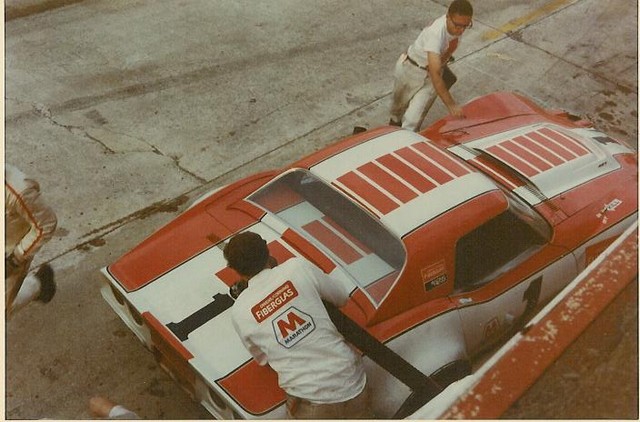
(Photo by Roger Holliday/The DeLorenzo Collection)
Driver change for the GT winners in the 1970 12 Hours of Sebring. Randy Wittine can be seen re-fueling, while Rollie Aiken gets ready to lift the hood.
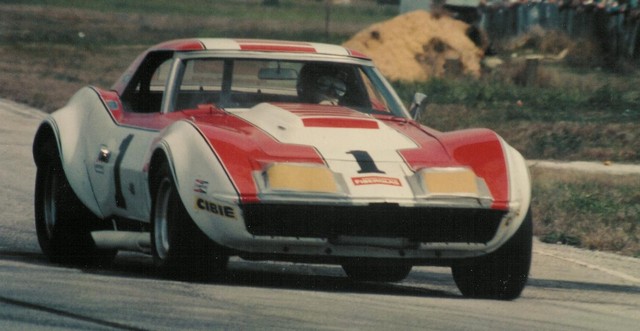
(The DeLorenzo Collection)
The 1970 12 Hours of Sebring was a defining moment for the Owens/Corning Fiberglas Corvette Racing Team. Tony (with Dick Lang co-driving) finished 1st in GT +5.0L and 10th overall. It was the team's third consecutive win in a major FIA endurance race, establishing the team as a force to be reckoned with in international racing.
Editor's Note: Many of you have seen Peter's references over the years to the Hydrogen Electric Racing Federation (HERF), which he launched in 2007. For those of you who weren't following AE at the time, you can read two of HERF's press releases here and here. And for even more details (including a link to Peter's announcement speech), check out the HERF entry on Wikipedia here. -WG
Publisher's Note: As part of our continuing series celebrating the "Glory Days" of racing, we're proud to present another noteworthy image from the Ford Racing Archives. - PMD
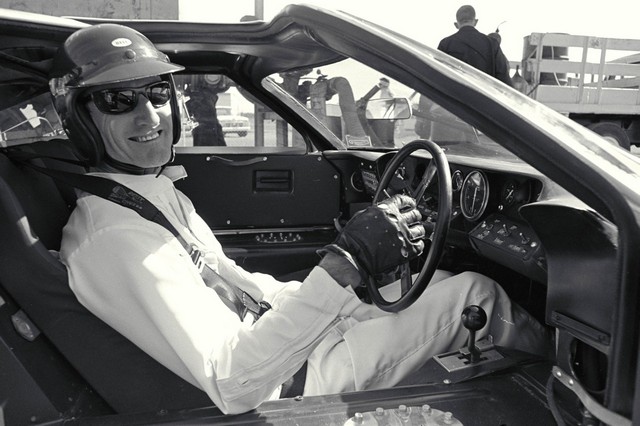 (Courtesy of the Ford Racing Archives)
(Courtesy of the Ford Racing Archives)
Daytona Beach, Florida, 1966. The great Ken Miles sits in the cockpit of the No. 98 Shelby American Ford Mk II during practice for the 1966 Daytona 24 Hour race. He and Lloyd Ruby would lead a 1-2-3 sweep for Ford, finishing eight laps ahead of the No. 97 Shelby American Ford Mk II driven by Dan Gurney and Jerry Grant. Walt Hansgen and Mark Donohue would finish third in the No. 95 Holman & Moody Mk II. Check out a sensational collection of Dave Friedman images from that race weekend here.

